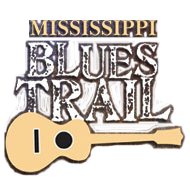Hill Country Blues
Hill Country Blues - Holly Springs
Although Delta blues often claims the spotlight, other styles of the blues were produced in other regions of Mississippi. In the greater Holly Springs area, musicians developed a “Hill Country” blues style characterized by few chord changes, unconventional song structures, and an emphasis on the "groove" or a steady, driving rhythm. In the 1990s this style was popularized through the recordings of local musicians R.L. Burnside and David “Junior” Kimbrough. “Hill Country Blues” refers to traditional forms of blues music played in the hilly areas of northeast Mississippi as well as in adjacent areas of Tennessee. The term wasn’t used widely until the 1990s in the wake of Robert Mugge’s documentary Deep Blues, which featured David “Junior” Kimbrough, R.L. Burnside, and Jessie Mae Hemphill from the Como/Senatobia area, the popularity of rock-blues groups including the North Mississippi Allstars, and media coverage of albums by Kimbrough, Burnside, Robert Belfour, Kenny Brown and others on the Oxford-based Fat Possum label.
Early recordings by Mississippi Fred McDowell and his student R.L. Burnside both appeared on albums with “Delta blues” in the title, but “Hill Country blues” was later widely used by scholars, the industry and fans of alternative rock who found resonance with the music. Some local musicians have embraced the term, although Kimbrough from nearby Hudsonville insisted that he played “cotton-patch blues” at juke joints that he ran across the area, including here in Holly Springs and in Chulahoma. His definition was embraced by his musical sons David, Jr., Kinney, and Robert, Sr. and grandson Cameron.
Kimbrough’s legacy continued to be celebrated at the annual Kimbrough Cotton Patch Soul Blues Fest, and regional music was also publicized widely via the North Mississippi Hill Country Picnic, founded in 2006 by Brown, Burnside’s long time guitarist, and his wife, Sara Davis. The festival emphasized the importance of local musical family traditions—in addition to the Kimbroughs, multiple of R.L. Burnside’s family members were his musical collaborators, notably sons Joseph, Daniel, Duwayne and Garry, son-in-law Calvin Jackson, who was the father of Cedric Burnside. Junior Kimbrough’s longtime bassist Joe Ayers and his son Trenton also both made recordings under their own names.
Another major center for traditional north Mississippi music is the Como/Senatobia area, and particularly the fife and drum tradition. Musical patriarch Sid Hemphill’s daughter Rosa Lee Hill and granddaughter Jesse Mae Hemphill continued his musical legacy. Brothers Ed, G.D. and Lonnie Young, Sr., and Lonnie Jr. were another family group, and Otha Turner played over the years with multiple family members, including daughter Bernice Pratcher, granddaughter Sharde Thomas, and nephew R.L. Boyce. The daughters of brothers Miles and Bob Pratcher, who played in a fiddle/guitar duo, recorded as the gospel group the Como Mamas. Many recordings of traditional artists in the area were made by researchers. Alan Lomax visited the area in 1942, though he was in the broader area in 1941 and ‘42, and in 1959 ethnomusicologist David Evans issued his recordings on Memphis State’s High Water Record Company, and Dr. Sylvester Oliver ran Rust College’s Rustron label and also ran the Northeast Mississippi Blues and Gospel Folk Festival. George Mitchell made recordings that were issued on labels including Arhoolie, whose owner Chris Strachwitz also documented local artists.
This is marker No. 45 on the Mississippi Blues Trail, dedicated July 3, 2008, and content updated in 2024.
Record label and covers, and High Water Records courtesy Jim O’Neal, BluEsoterica Archives, and Scott Barretta; research assistance Dr. David Evans
content © Mississippi Blues Commission
[ BACK TO TOP ]

